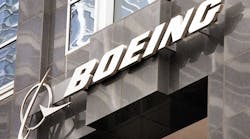Boeing Co. is deepening its intrusion on suppliers’ turf by teaming up with France’s Safran SA to design and build auxiliary power units, the compact turbines tucked below a jetliner’s tail that are used to start its main engines and provide power on the ground.
The 50-50 partnership will be based in the U.S., the companies said in a statement Monday. The deal is expected to close later this year, pending regulatory approval. Financial terms weren’t disclosed.
The strategy brings the world’s largest aerospace company into a closer partnership with Paris-based Safran to challenge United Technologies Corp. and Honeywell International Inc., the leading manufacturers of the auxiliary power units, or APUs. Safran already provides the main engines for Boeing’s 737 narrow-body aircraft through a venture with General Electric Co.
“The big loser here is Honeywell,” said consultant Kevin Michaels, managing director of AeroDynamic Advisory. “The APU is the largest portion of your gas-turbine portfolio and your biggest customer is now going to be competing with you.”
United Technologies is cushioned against potential sales loss to Boeing, Michaels said, since its Pratt & Whitney unit is a major manufacturer of jet engines in addition to the APUs. “There are economies of scale for a gas-turbine manufacturer,” he said.
In-House Work
Boeing rose 1.1% to $360.73 at the close of trading in New York. Safran fell 1.3% to 102.35 euros in Paris. United Technologies rose less than 1%, while Honeywell was little changed.
The venture bolsters Boeing’s push into vertical integration, as it targets certain work handled by suppliers. That’s a reverse of the outsourcing strategy that peaked with design and manufacturing work on its 787 Dreamliner a decade ago. Boeing is re-engineering the production system for a proposed mid-range model to make money over a plane’s typical commercial life of 30 years.
Boeing created a division last year to reap more sales of higher-margin services, from parts distribution to retrofitting aircraft. Chief Executive Officer Dennis Muilenburg has set a goal of more than tripling revenue at the unit to $50 billion within a decade.
‘Vertical’ Value
“We don’t need to be vertical everywhere, but there are some key areas where we want to be vertical for the future where it’s going to create better product value or it’s going to create life-cycle value to grow services,” Muilenburg told a Bernstein conference last week. “We still need a world-class supply chain to go with that.”
Boeing is already building the carbon-composite wings for its new 777X jetliner, forming a venture that manufactures high-end aircraft seating and creating a business that focuses on avionics, the communications and computer equipment that serve as the brains of an aircraft.
The strategy has contributed to a wave of supplier consolidation, including United Technologies’ pending $23 billion takeover of Rockwell Collins Inc., a major avionics manufacturer.
Reshaping Aviation
The new vertical businesses sprouting within Boeing may also position the company for trends that could reshape aviation in the 2020s, from battery-powered aircraft to critical pilot shortages, Michaels said.
Boeing’s avionics business would be a profit center if the planemaker hones artificial intelligence so jetliners can be flown by a single pilot, he said. The auxiliary power units provide a critical backup for hybrid-electric planes being developed by Boeing-backed Zunum Aero.
The near-term profit outlook for the new Boeing-Safran partnership is less certain. Customers of the so-called 797 would “revolt” if Boeing required them to purchase its power unit instead of giving them a choice, Michaels said. He doesn’t see much windfall for the services division, either.
“The whole APU overhaul market is about $1.5 billion a year, and that’s split all kinds of ways,” Michaels said.
By Julie Johnsson




